The last Soviet IFV
The BMP-3 was the last Soviet-era infantry fighting vehicle (IFV) produced following the BMP-1 and BMP-2. With roughly 2,000 produced, it remains in service today with a number of different operators. They are by far the most capable of the whole BMP lineage with a main armament equal to that of a medium tank. In fact, their main cannon is equivalent to the one sported by the T-54/55. Although much costlier than earlier models, the BMP-3 set a whole new level in IFV design in the 1980s. It had an unconventional layout and 17 variants emerged. The BMP-3 first saw active service in the first Chechen war and Saudi Arabian-led intervention in Yemen. Aside from Russia, it is operated today by 11 other countries, with proposals for more. Its planned replacement is the Armata-based Kurganets-25 (revealed in 2015).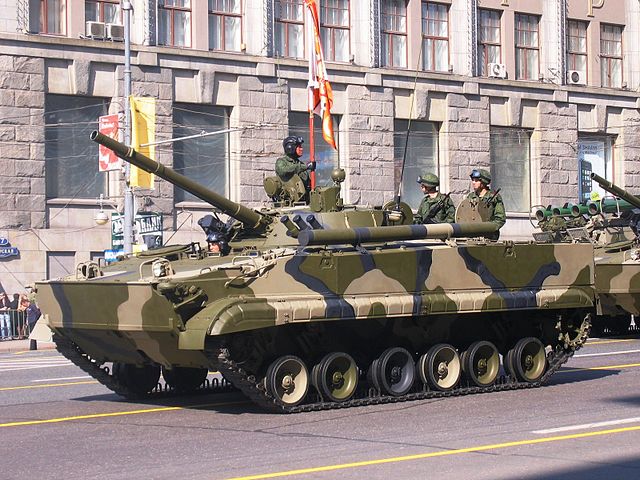
BMP-3, Moskow parade rehearsal
Development history
First studies started in 1975, with the Obyekt 685 light tank prototype that sported the 100 mm gun 2A48-1. The definitive BMP-3 was designed and produced by the Kurganmashzavod ("Kurgan Machine Building Plant"). A few variants were built by the Rubtsovsk Machine Building Plant (RMZ).Design of the BMP-3
The hull of this new BMP-3, made of high-strength aluminum alloy, has a new configuration compared to previous designs. Its unconventional layout has the engine placed in the back right position unlike most IFVs (typically in the forward left position). The driver therefore sits in the centre together with two infantrymen. Five additional infantrymen are seated aft of the two-man turret. The bottom of the BMP-3 has a double hull and the engine is squeezed under the floor of the vehicle. Troops can exit the vehicle from the rear, literally running over the engine. The outside of the vehicle has firing ports and vision blocks, the vehicle carries an R-173 transceiver and R-173P receiver.Protection
Armour is provided by an extra steel plate welded over the aluminum hull and turret, and the spaced armor procured by the trim vane, as like previous IFVs. The turret is also provided with a thick steel spaced armor shield over its frontal arc. Protection against 30 mm gun rounds at about 200 m is assured at the front, machine gun rounds elsewhere. Another interesting feature in passive protection consists of the self-sealing fuel tank being placed in front of the driver, and directly behind the front armor plating. This is built to act as extra armor, most effective against shaped charge warheads, and auto-cannon shells that penetrate the frontal armor. The standard weight of the vehicle is 18.7 tonnes but reaches 22.2 tonnes with all the add-on armor panels mounted. Equipped with such a kit, the vehicle is immune to 12.7 mm machine gun rounds at a range of 100–200 m.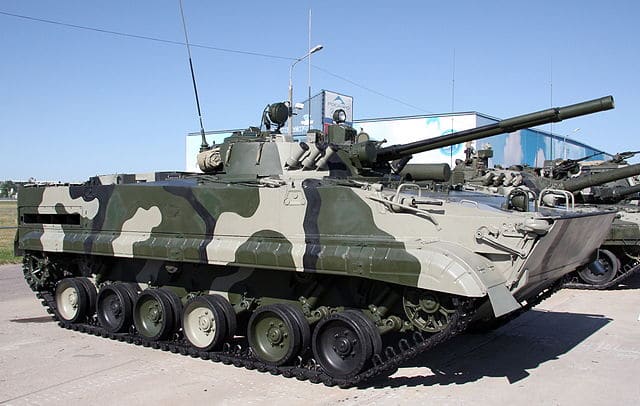
Two sets of explosive reactive armor kits (ERA) are currently available: The Kaktus ERA kit (minimal acoustic and kinetic backlash to the armor behind it upon detonation) and additional side armor tiles immune to .50 caliber armor-piercing ammunition at close range, plus side protection from autocannon fire. Other optional equipment includes the Shtora electro-optical jammer disrupting Semi-automatic command to line of sight (SACLOS) anti-tank guided missiles signals as well as laser rangefinders and target designators. For active protection, the BMP-3 possesses two banks of three 902V "Tucha-2" 81 mm smoke grenade launchers. Each vehicle can also lay its own smoke screen by injecting fuel into the exhaust manifolds. The protection kit also includes a chemical agent detector, an FVU filtration system, and automatic fire extinguishers for the main and engine compartments, plus the usual collective nuclear biological and chemical (NBC) protection system.
Armament
With a low-velocity 2A70 100 mm rifled gun, the BMP-3 outmatches most IFVs in service by caliber. The main gun can fire conventional shells but also (and most importantly) 9M117 ATGMs (AT-10 Stabber) which compensates for the lack of muzzle velocity. The gun elevates from −5° to +60°. Forty 100 mm-rounds and 8 ATGMs are stored total. The 100 mm gun, already impressive enough, is complemented by a coaxial high-velocity 2A72 30 mm dual feed auto-cannon, capable of 350 to 400 RPM. 500 (300 HEI and 200 APT) rounds are carried. Also coaxially mounted is a standard 7.62mm (0.3 in) PKT machine gun with 2,000 rounds. The hull is also armed with a pair of PKT bow machine guns, each with a supply of 2000 rounds. This makes the BMP-3 certainly the most heavily armed IFV in service worldwide. The main command sight allows engagement of targets 5,000–6,000 meters out with the 9K116-3 "Basnya" ATGM. The range drops down to 4,000 meters with HE-Frag 3OF32 shells. The sight includes a 1D16-3 laser designator and two-plane stabilizer 2E52-2 allowing, according to the manufacturer, accurate fire on the move as well as when swimming.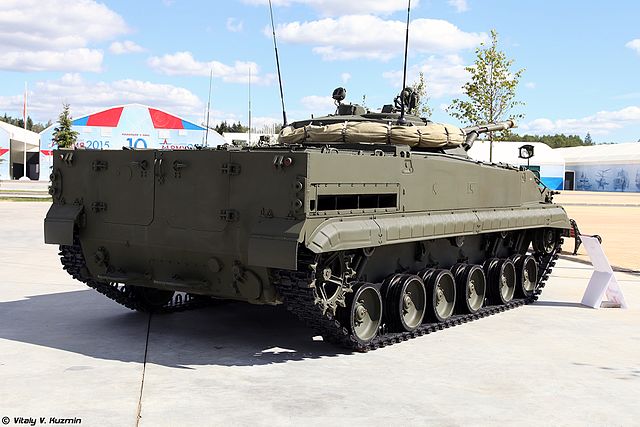
Rear view of a BMP-3
The turret's own automatic loader 2K23 can feed 22 ready rounds (18 more rounds stored in the hull). There is a 1V539 ballistic computer, cross-wind sensor, 1K13-2 gunner's sight/guidance device, PPB-1 gunner's sight, and OU-5-1 IR searchlight. The commander is given an optical sight 1PZ-10, doubled by a day/night vision TKN-3MB plus IR searchlight OU-3GA2. In 2005, the Peleng fire control system (Belarus) was introduced and consists of a SOZH-M gunner's sight, integrated laser RF, new missile-guidance channel, Vesna-K targeting system with thermal imaging camera, automatic target tracker AST-B, new stabilization system, new ballistic computer, revised sensors and PL-1 IR laser projector.
Mobility
The first batches of the BMP-3s were equipped with the UTD-29, 450 hp engine. Later production series were given the 500 hp UTD-29M. Developed at the Transmash Diesel Engine Plant in Barnaul it provides a range of 600 km (370 mi) for an output of 27 hp/tonne. This is a four-stroke, liquid-cooled diesel coupled with a four-speed hydro-mechanical power unit transmission and with power takeoff for two water jets (single-stage, axial, auger-type). The steering systems use a gear differential with hydrostatic drive. There is also a track adjusting mechanism, remotely controlled from the driver's station, including tension force indication. Registered top speeds are 72 km/h (45 mph) on road, 45 km/h (28 mph) off-road and 10 km/h (6.2 mph) when swimming. The suspension counts torsion bars on all six double-wheel units and hydraulic shock absorbers. Drive sprockets are at the rear, idler at the front, and the tracks rest on three return rollers per side. As a standard, there is no rubber-type or rigid side skirt protection. Aside from the fact that the BMP-3 is amphibious, it is also light enough to be carried by cargo planes.BMP-3 Variants
BMP-3M Upgrade by KBP and Kurganmashzavod which features a new turret and engine. The turret includes a new automatic fire control system with ballistic computer, new SOZH gunner's sight and laser rangefinder plus an ATGM guidance channel, a thermal imager, a new TKN-AI commander's vision device, laser illuminator and new ammunition loading system for ATGM. It also opens a whole new range of 100 mm laser-guided ammunitions, HE-FRAG rounds and APDS (armor piercing discarding sabot) rounds. Passive armor is now immune to 12.7 mm armor-piercing rounds at 50 m range. The engine is now a 660 hp UTD-32. Sub-variants of the M includes additional armor, "Arena-E"/"Shtora-1" systems, options like an air conditioner.BMMP (bojevaya mashina morskoj pekhoti) Naval infantry version fitted with BMP-2 turret.
BMP-3K (komandnyi) Tactical command variant fitted with the R-173 radio, larger intercom system, AB-R28 independent portable power unit, TNA-4-6 navigation kit, "Ainet" round fuzing capability. No bow machine guns, whip antennas mounted at the rear and 3+3 crew.
BMP-3F Rebuilt naval variant with improved seaworthiness, buoyancy, state 3 sea swimming, being even capable of firing accurately at sea state 2. To achieve this, there is no self-entrenching equipment, a lightweight vane, and an air intake tube fitted. The turret also is protected by anti-surge vanes. The refurbished water jet propellers allow for a 10 km/h swim. The BMP-3F is able to come ashore under rough sea and towing another similar model. A SOZH targeting system with integrated laser rangefinder and ATGM guidance channel is also installed, proven to seven hours of continuous rough seas operations.
BRM-3K "Rys" (Ob.501) 1993 Surveillance variant: 1PN71 thermal sight (3.7x/11x, 3 km range), 1PN61 active-pulse night vision device (3 km range), 1RL-133-1 ("TALL MIKE") I-band surveillance radar (3 km personnel, 12 km vehicle), 1V520 computer and a TNA-4-6 navigation system. Armament reduced to the stabilized 30 mm gun 2A72 plus coaxial 7.62 mm machine gun. BMP-3 Dragoon Modernised BMP-3 with an unmanned turret, new power plant moved to the front, and hydraulic ramp. Intended mostly for export.
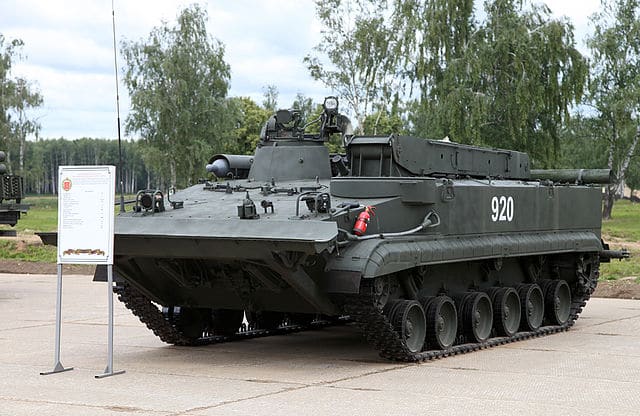
BREM-L variant at the tank bihatlon 2014
BREM-L "Beglianka" (Ob.691) Armoured recovery vehicle with five-tonne crane and 20/40 metric tonne capacity winch.
9P157-2 "Khrizantema-S" Specialised Anti-tank version fitted with the Khrizantema (AT-15) system, radar and laser guidance. Two 9M123 missiles on launch rails, radar stowed and deployed during transit. Automatic reloading system, internal magazine for more 15 more in sealed canisters. Optional manual external loading from the outside. Dual guidance system for electronic countermeasures, operation in all weather conditions and night operations. 9M123 missiles are supersonic (400 m/s or Mach 1.2), range 400-6,000 meters. 10 are operational at Ingushetia, November 2012, as part of artillery units.
9P163M-1 "Kornet-T" Second anti-tank version, Kornet (AT-14) missile system. Two 9M133 missiles on extensible launch rails, 16 rounds in reserve, and automatic loader. 9P163M-1 guidance system allowing two missiles to be fired at once, on different laser channels. First delivered in 2003 (replaced Shturm-S) first 20 in service by 2012, given to motorised units.
2S18 "Pat-S" (Ob.697) Self-propelled 152 mm howitzer 2A61 "Pat-B", prototype, later giving the 2S31.
2S31 "Vena" Fire support vehicle, 120 mm mortar (2010)
DZM "Vostorg-2" CEV (Combat engineer vehicle) with a dozer blade and excavating bucket, Prototype.
UR-07 Mine clearing vehicle replacing the UR-77 "Meteorit". Bigger steel hull, two rear launch ramps for firing rockets towing hose-type mine-clearing line charges.
UNSh (Ob.699) Basic chassis for specialized variants.
KhTM Driver trainer variant
TKB-841 Hermes Air-defence vehicle with high-velocity missiles and radar system (prototype).
UDAR Unmanned ground vehicle, centre hull raised to fit the Epoch Remote Control Turret.

Venezuelan BMP-3 in parade.
Exports
Outside of the Russian Army (More than 720 vehicles, 200 more in delivery), the BMP-3 has been sold to Azerbaijan (100 BMP-3M), Cyprus (43 in 1995), Indonesia (17+37 BMP-3F in 2010 and 2014), Kuwait (118 in 1995 and about 200 by 2014), South Korea (33 in 1996, 37 in 2005), Libya (14 9P157-2 TDs), Ukraine (4) United Arab Emirates (250: Abu Dhabi, 402: Dubai in 1992–1997 with "Namut" thermal sight, modular armour "Kaktus", UTD-32 engine), Turkmenistan (4), Venezuela (130 BMP-3M), and Morocco (60) - apparently not yet delivered. In addition, the BMP-3 was proposed to Greece and India but without success, whereas Iraq, Saudi Arabia and Brazil are potential operators that contacted the company.Service history
The BMP-3 was first shown in public during the 1990 Victory Day parade. It has been given the NATO code IFV M1990/1. In total, since then, the BMP-3 serial production underwent 1,500 modifications. The BMP-3 had its nose bloodied for the first time with the First Chechen War. Second notable engagements and combat action were with Emirati forces in the Saudi Arabian-led intervention in Yemen, where it remains actively deployed. In May 2015, a three-year contract was signed for "hundreds" of additional BMP-3s until replacement by the Kurganets-25 in last stages of development. The BMP-3 is currently marketed by Rosobonexport in two variants: The basic BMP-3 (add-on armour, SOZH-M sighting system, FOV gun stabilizer, Vesna-K night sight) but also the BMP-3F optimized for marine operations. The latter features anti-surge vanes on the turret, and an improved lightweight anti-surge vane for the driver, elongated telescopic air intake snorkel and the Self-entrenching equipment is retired.Links & sources
On sovietarmourblogroe.com - Robosonexport page
additional data fas.org
Also army-technology.com, military-today.com and armyrecognition.com
Additional open source photos (wikimedia)
BMP-3 specifications |
|
| Dimensions | 7.14 m x 3.2 m x 2.4 m (23ft 5in x 10ft 6in x 7ft 1in) |
| Total weight, battle ready | 18.7 tonnes |
| Crew | 3+7 (driver, cdr, gunner, 7 infantry) |
| Propulsion | UTD-29M diesel 500 hp (375 kW) 27 hp/tonne |
| Suspension | Independent shock absorbers and torsion bars |
| Speed (road) | 72/45/10 km/h (road/off-road/water) |
| Range | 600 km (370 miles) |
| Armament | 100 mm gun/launcher, 30 mm autocannon, 3x PKT 7.62 mm MGs |
| Armor | 35 mm frontal arc to 8 mm (1-1.2 in) |
| Total production | 2000 - current |
Gallery
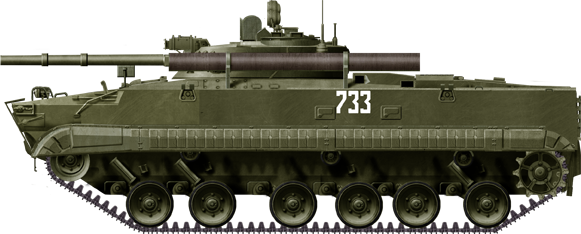
Early BMP-3
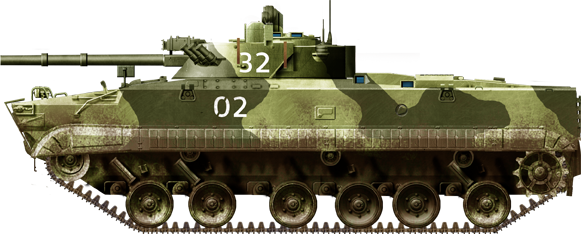
Camouflaged BMP-3, 2 tone camouflage
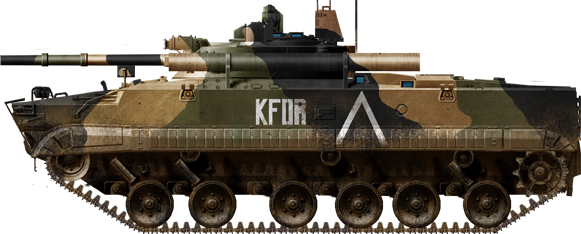
BMP-3 KFOR, ex-Yugoslavia, 1995
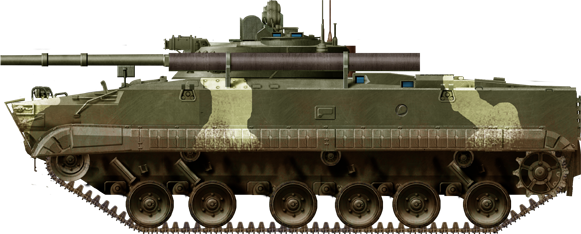
Russian camouflaged BMP-3
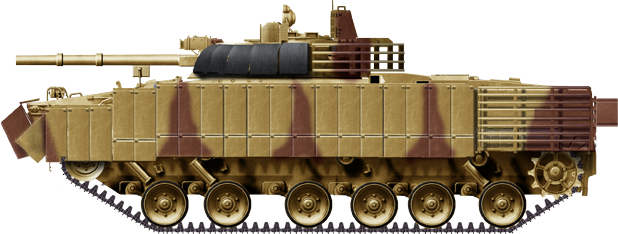
UAE BMP-3 ERA
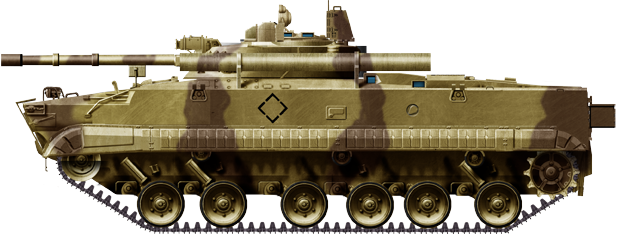
UAE BMP-3
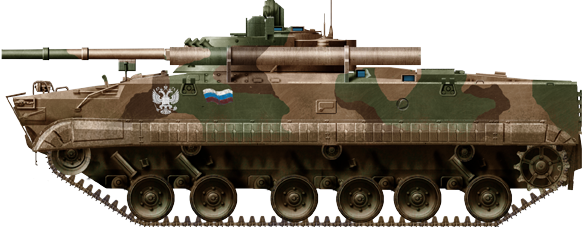
Russian BMP-3
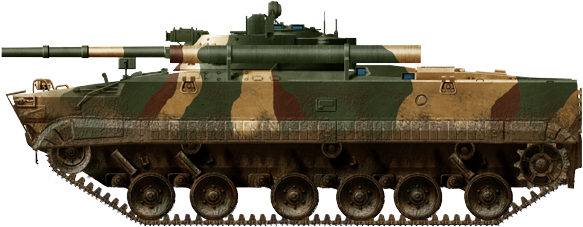
South Korean BMP-3
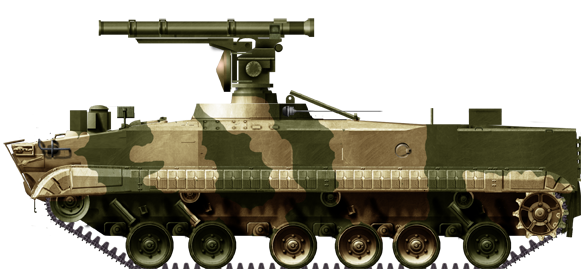
9P157-2 "Khrizantema-S version.
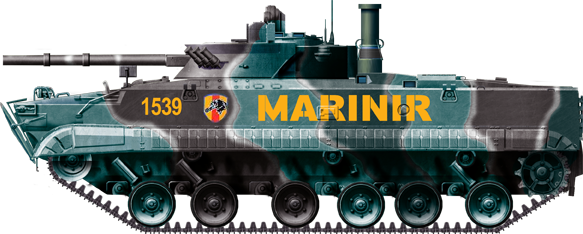
BMP-3F Marinir (Indonesian Marines)
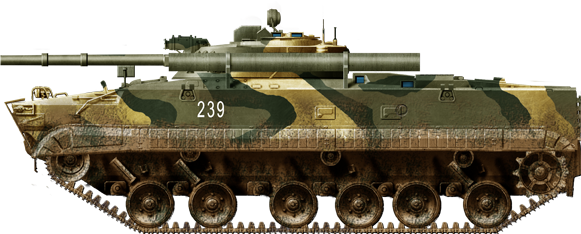
Russian camouflage
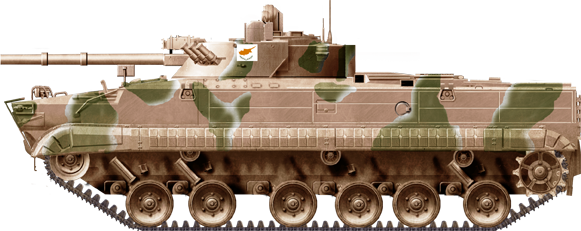
Cypriot BMP-3
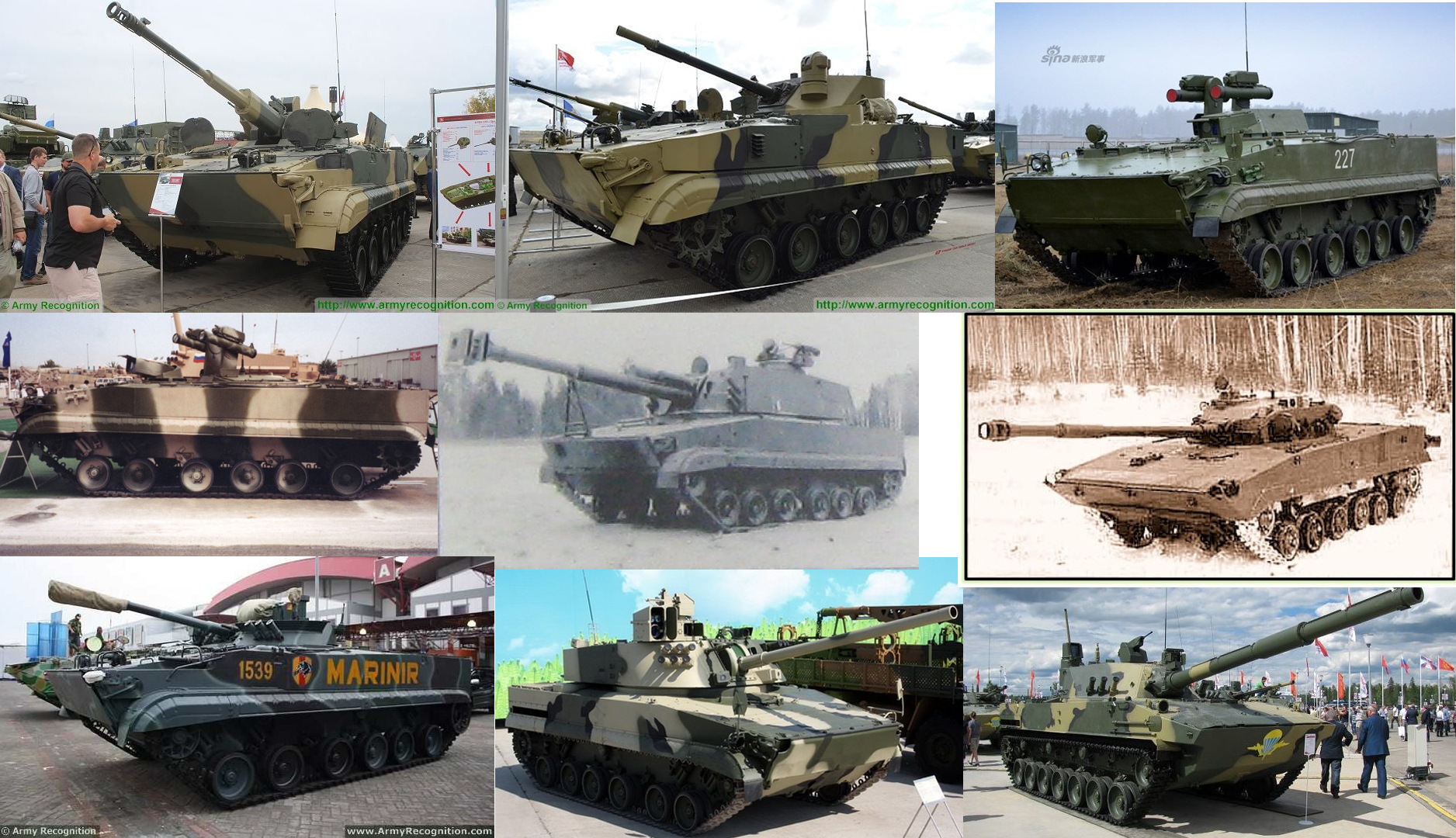
Various references of variants
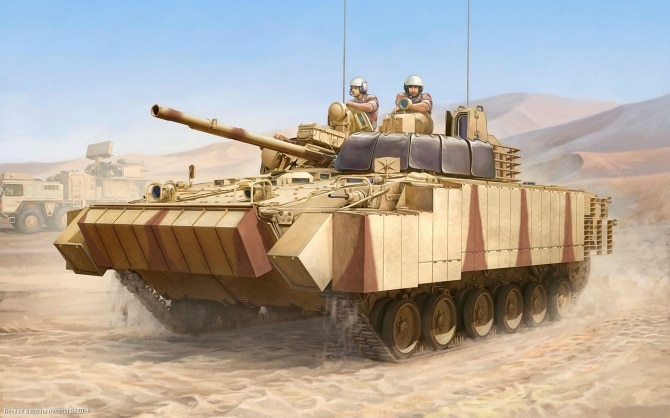
BMP-3 of the United Arab Emirates - model kit artist rendition
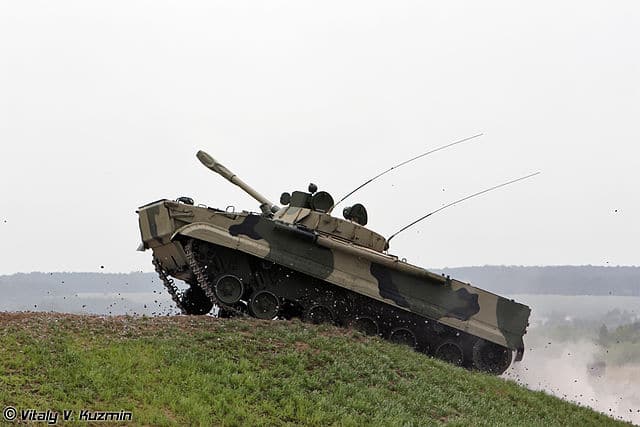
Russian BMP-3 at ETIF-2010
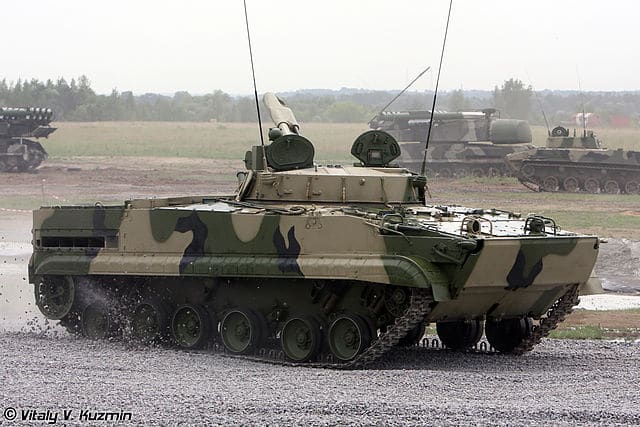
Russian BMP-3 at ETIF-2010
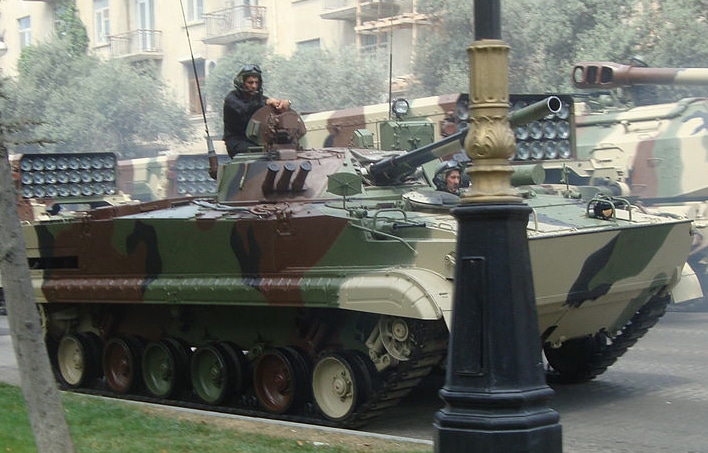
BMP-3 Azeri in a parade at Baku
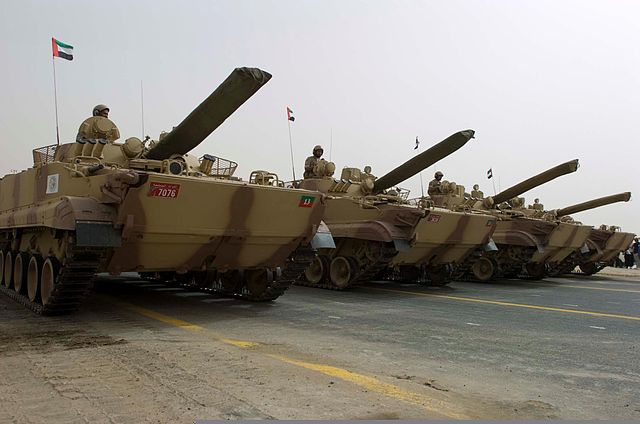
UAE BMP-3
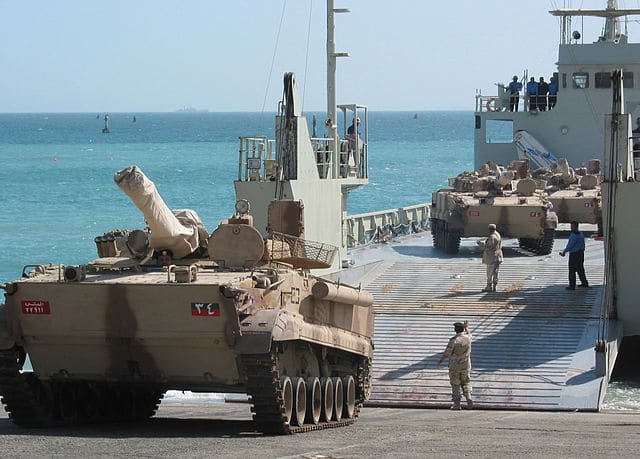
BMP-3 of the UAE landing in a Kuwait port in a joint exercize - USN photo

Cold War Tanks


































Cold war tanks posters

Cold War Main Battle Tanks

Cold War Soviet Army

